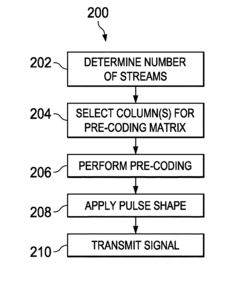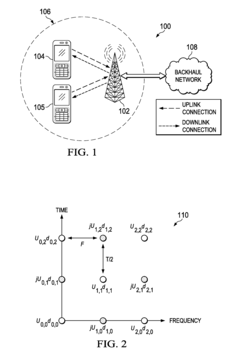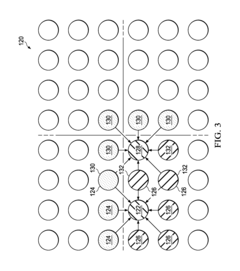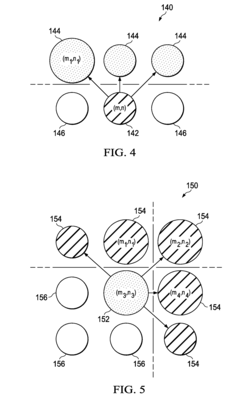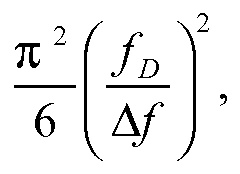OFDM Vs QAM: Assessing Bandwidth Efficiency in Satellite Links
SEP 12, 20259 MIN READ
Generate Your Research Report Instantly with AI Agent
Patsnap Eureka helps you evaluate technical feasibility & market potential.
Satellite Modulation Evolution and Objectives
Satellite communication technology has evolved significantly since its inception in the 1960s, with modulation techniques playing a crucial role in this development. The progression from simple binary modulation schemes to complex digital techniques reflects the industry's continuous pursuit of greater bandwidth efficiency, reliability, and adaptability to challenging space environments.
Early satellite communications relied on basic modulation techniques such as Binary Phase Shift Keying (BPSK) and Quadrature Phase Shift Keying (QPSK). These fundamental approaches provided reliable transmission but offered limited spectral efficiency. As demand for satellite bandwidth increased in the 1980s and 1990s, higher-order Quadrature Amplitude Modulation (QAM) schemes emerged, enabling more bits per symbol and consequently higher data rates within the same bandwidth.
The 2000s witnessed a paradigm shift with the introduction of Orthogonal Frequency Division Multiplexing (OFDM) in terrestrial communications, which eventually found applications in satellite systems. OFDM's ability to combat frequency-selective fading and efficiently utilize available spectrum presented new possibilities for satellite link optimization, particularly in challenging propagation environments.
Current satellite communication systems face increasing demands for higher throughput, lower latency, and greater reliability. Modern high-throughput satellites (HTS) require advanced modulation techniques to maximize capacity while maintaining acceptable error rates. The industry is now at a critical juncture where traditional QAM techniques and newer OFDM approaches must be evaluated for their respective merits in satellite applications.
The primary technical objective in this domain is to determine which modulation scheme—OFDM or QAM—provides superior bandwidth efficiency for satellite links under various operational conditions. This assessment must consider the unique challenges of satellite communications, including long propagation delays, limited power resources, and exposure to atmospheric interference.
Secondary objectives include evaluating implementation complexity, power efficiency, and compatibility with existing satellite infrastructure. The analysis must also account for emerging requirements such as flexibility to support diverse applications, from broadband internet to IoT connectivity, and adaptability to dynamic channel conditions in different orbital configurations.
This technical investigation aims to provide a comprehensive comparison framework that satellite operators, equipment manufacturers, and service providers can use to make informed decisions about modulation techniques for current deployments and future satellite communication systems. The findings will contribute to the ongoing evolution of satellite communication standards and potentially influence the design of next-generation satellite payloads.
Early satellite communications relied on basic modulation techniques such as Binary Phase Shift Keying (BPSK) and Quadrature Phase Shift Keying (QPSK). These fundamental approaches provided reliable transmission but offered limited spectral efficiency. As demand for satellite bandwidth increased in the 1980s and 1990s, higher-order Quadrature Amplitude Modulation (QAM) schemes emerged, enabling more bits per symbol and consequently higher data rates within the same bandwidth.
The 2000s witnessed a paradigm shift with the introduction of Orthogonal Frequency Division Multiplexing (OFDM) in terrestrial communications, which eventually found applications in satellite systems. OFDM's ability to combat frequency-selective fading and efficiently utilize available spectrum presented new possibilities for satellite link optimization, particularly in challenging propagation environments.
Current satellite communication systems face increasing demands for higher throughput, lower latency, and greater reliability. Modern high-throughput satellites (HTS) require advanced modulation techniques to maximize capacity while maintaining acceptable error rates. The industry is now at a critical juncture where traditional QAM techniques and newer OFDM approaches must be evaluated for their respective merits in satellite applications.
The primary technical objective in this domain is to determine which modulation scheme—OFDM or QAM—provides superior bandwidth efficiency for satellite links under various operational conditions. This assessment must consider the unique challenges of satellite communications, including long propagation delays, limited power resources, and exposure to atmospheric interference.
Secondary objectives include evaluating implementation complexity, power efficiency, and compatibility with existing satellite infrastructure. The analysis must also account for emerging requirements such as flexibility to support diverse applications, from broadband internet to IoT connectivity, and adaptability to dynamic channel conditions in different orbital configurations.
This technical investigation aims to provide a comprehensive comparison framework that satellite operators, equipment manufacturers, and service providers can use to make informed decisions about modulation techniques for current deployments and future satellite communication systems. The findings will contribute to the ongoing evolution of satellite communication standards and potentially influence the design of next-generation satellite payloads.
Market Demand Analysis for Satellite Bandwidth Efficiency
The satellite communications market is experiencing unprecedented growth, driven by increasing demand for high-speed connectivity in remote areas, maritime operations, aviation, and military applications. The global satellite communications market was valued at $66.63 billion in 2020 and is projected to reach $126.5 billion by 2028, growing at a CAGR of 9.8% during the forecast period. This growth trajectory underscores the critical importance of bandwidth efficiency technologies like OFDM and QAM in satellite links.
Bandwidth efficiency has become a paramount concern for satellite operators facing spectrum scarcity and growing data transmission requirements. End-users across various sectors demand higher throughput without corresponding increases in operational costs. Commercial satellite internet providers report customer expectations for broadband-like experiences with download speeds exceeding 100 Mbps, even in remote locations, creating pressure for more efficient modulation schemes.
The enterprise segment, particularly multinational corporations with global operations, represents a significant market driver. These organizations require reliable, high-capacity satellite links for their distributed operations, with bandwidth requirements growing at approximately 25% annually. The COVID-19 pandemic has accelerated this trend, as remote work arrangements have increased dependency on robust satellite communications infrastructure.
Government and defense sectors constitute another major market segment, with military applications demanding secure, high-capacity satellite links resistant to interference. Defense agencies worldwide are investing heavily in satellite communications infrastructure, with the U.S. Department of Defense allocating $15.3 billion for space and satellite systems in its 2022 budget.
The maritime and aviation sectors present rapidly expanding markets for bandwidth-efficient satellite technologies. The commercial maritime industry requires increasingly efficient connectivity solutions for vessel operations, crew welfare, and passenger services. Similarly, the in-flight connectivity market is projected to grow substantially, with passengers expecting seamless broadband experiences comparable to terrestrial networks.
Emerging markets in Africa, South America, and parts of Asia represent significant growth opportunities, as these regions often lack extensive terrestrial infrastructure. Satellite operators targeting these markets face unique challenges in delivering cost-effective services, making bandwidth efficiency technologies particularly valuable.
Market research indicates that satellite operators are willing to invest in advanced modulation technologies that can deliver 30-40% improvements in bandwidth efficiency, with return on investment expected within 24-36 months. This creates a compelling business case for continued innovation in OFDM and QAM implementations for satellite communications.
Bandwidth efficiency has become a paramount concern for satellite operators facing spectrum scarcity and growing data transmission requirements. End-users across various sectors demand higher throughput without corresponding increases in operational costs. Commercial satellite internet providers report customer expectations for broadband-like experiences with download speeds exceeding 100 Mbps, even in remote locations, creating pressure for more efficient modulation schemes.
The enterprise segment, particularly multinational corporations with global operations, represents a significant market driver. These organizations require reliable, high-capacity satellite links for their distributed operations, with bandwidth requirements growing at approximately 25% annually. The COVID-19 pandemic has accelerated this trend, as remote work arrangements have increased dependency on robust satellite communications infrastructure.
Government and defense sectors constitute another major market segment, with military applications demanding secure, high-capacity satellite links resistant to interference. Defense agencies worldwide are investing heavily in satellite communications infrastructure, with the U.S. Department of Defense allocating $15.3 billion for space and satellite systems in its 2022 budget.
The maritime and aviation sectors present rapidly expanding markets for bandwidth-efficient satellite technologies. The commercial maritime industry requires increasingly efficient connectivity solutions for vessel operations, crew welfare, and passenger services. Similarly, the in-flight connectivity market is projected to grow substantially, with passengers expecting seamless broadband experiences comparable to terrestrial networks.
Emerging markets in Africa, South America, and parts of Asia represent significant growth opportunities, as these regions often lack extensive terrestrial infrastructure. Satellite operators targeting these markets face unique challenges in delivering cost-effective services, making bandwidth efficiency technologies particularly valuable.
Market research indicates that satellite operators are willing to invest in advanced modulation technologies that can deliver 30-40% improvements in bandwidth efficiency, with return on investment expected within 24-36 months. This creates a compelling business case for continued innovation in OFDM and QAM implementations for satellite communications.
OFDM and QAM Technical Status and Challenges
The global landscape of OFDM and QAM technologies in satellite communications presents a complex picture of advancement and challenges. Currently, Quadrature Amplitude Modulation (QAM) remains the predominant modulation scheme in traditional satellite links, with implementations ranging from 16-QAM to 256-QAM depending on the application requirements. Higher-order QAM configurations are increasingly being deployed in high-throughput satellites (HTS) to maximize spectral efficiency under favorable channel conditions.
Orthogonal Frequency Division Multiplexing (OFDM), while well-established in terrestrial communications, has seen more limited adoption in satellite systems. Recent advancements have addressed many of the historical limitations, with DVB-S2X standards now incorporating OFDM-based techniques for specific use cases. The technology has demonstrated particular promise in mobile satellite applications where Doppler shifts and multipath fading present significant challenges.
A primary technical challenge for both modulation schemes in satellite environments is the high peak-to-average power ratio (PAPR), which is especially problematic for OFDM. This characteristic necessitates power back-off in satellite transponders, reducing overall power efficiency and potentially negating some of the bandwidth efficiency gains. Various PAPR reduction techniques have been developed, including selective mapping and tone reservation, though each introduces computational complexity and potential performance trade-offs.
Nonlinear distortion from satellite transponders presents another significant hurdle, particularly affecting higher-order QAM and OFDM signals. Pre-distortion techniques and improved linearization methods have emerged as partial solutions, though implementation complexity remains high for onboard processing. The long propagation delays in satellite links also create synchronization challenges for OFDM systems, requiring sophisticated timing and frequency offset correction mechanisms.
Geographically, development of advanced modulation techniques for satellite applications shows interesting distribution patterns. North American and European entities lead in theoretical research and standardization efforts, with companies like Hughes Network Systems and Viasat pioneering high-order QAM implementations. Asian manufacturers, particularly in Japan and South Korea, have made significant advances in OFDM hardware implementations for satellite applications, while European space agencies have focused on hybrid approaches combining elements of both technologies.
The efficiency-reliability trade-off remains a central challenge, with researchers working to develop adaptive modulation and coding schemes that can dynamically select between QAM and OFDM-based approaches based on channel conditions. Recent developments in machine learning algorithms show promise in optimizing this selection process, potentially offering significant improvements in overall link performance across varying atmospheric and interference conditions.
Orthogonal Frequency Division Multiplexing (OFDM), while well-established in terrestrial communications, has seen more limited adoption in satellite systems. Recent advancements have addressed many of the historical limitations, with DVB-S2X standards now incorporating OFDM-based techniques for specific use cases. The technology has demonstrated particular promise in mobile satellite applications where Doppler shifts and multipath fading present significant challenges.
A primary technical challenge for both modulation schemes in satellite environments is the high peak-to-average power ratio (PAPR), which is especially problematic for OFDM. This characteristic necessitates power back-off in satellite transponders, reducing overall power efficiency and potentially negating some of the bandwidth efficiency gains. Various PAPR reduction techniques have been developed, including selective mapping and tone reservation, though each introduces computational complexity and potential performance trade-offs.
Nonlinear distortion from satellite transponders presents another significant hurdle, particularly affecting higher-order QAM and OFDM signals. Pre-distortion techniques and improved linearization methods have emerged as partial solutions, though implementation complexity remains high for onboard processing. The long propagation delays in satellite links also create synchronization challenges for OFDM systems, requiring sophisticated timing and frequency offset correction mechanisms.
Geographically, development of advanced modulation techniques for satellite applications shows interesting distribution patterns. North American and European entities lead in theoretical research and standardization efforts, with companies like Hughes Network Systems and Viasat pioneering high-order QAM implementations. Asian manufacturers, particularly in Japan and South Korea, have made significant advances in OFDM hardware implementations for satellite applications, while European space agencies have focused on hybrid approaches combining elements of both technologies.
The efficiency-reliability trade-off remains a central challenge, with researchers working to develop adaptive modulation and coding schemes that can dynamically select between QAM and OFDM-based approaches based on channel conditions. Recent developments in machine learning algorithms show promise in optimizing this selection process, potentially offering significant improvements in overall link performance across varying atmospheric and interference conditions.
Current OFDM and QAM Implementation Solutions
01 OFDM with QAM for spectral efficiency optimization
Orthogonal Frequency Division Multiplexing (OFDM) combined with Quadrature Amplitude Modulation (QAM) provides significant improvements in spectral efficiency. By dividing the available bandwidth into multiple orthogonal subcarriers and applying QAM to each subcarrier, systems can achieve higher data rates without increasing bandwidth requirements. This combination allows for adaptive modulation techniques where the modulation order can be adjusted based on channel conditions to optimize the bandwidth efficiency while maintaining acceptable error rates.- OFDM modulation techniques for bandwidth efficiency: Orthogonal Frequency Division Multiplexing (OFDM) is a digital multi-carrier modulation technique that divides a channel into multiple orthogonal sub-carriers, allowing for efficient use of bandwidth. OFDM systems can achieve high spectral efficiency by closely spacing the sub-carriers without causing interference. This technique is particularly effective in combating frequency-selective fading and inter-symbol interference, making it suitable for high-speed data transmission in limited bandwidth environments.
- QAM modulation for spectral efficiency enhancement: Quadrature Amplitude Modulation (QAM) increases bandwidth efficiency by encoding multiple bits per symbol through variations in both amplitude and phase. Higher-order QAM schemes (16-QAM, 64-QAM, 256-QAM) can transmit more bits per symbol, significantly improving spectral efficiency. However, higher-order QAM requires better signal-to-noise ratio to maintain acceptable bit error rates. This modulation technique is widely used in digital communication systems where bandwidth is limited but channel conditions are favorable.
- Combined OFDM-QAM systems for optimized bandwidth utilization: The integration of OFDM with QAM modulation creates highly bandwidth-efficient communication systems. By applying QAM to individual OFDM subcarriers, these hybrid systems can achieve superior spectral efficiency while maintaining robustness against channel impairments. Adaptive modulation techniques can be implemented to dynamically adjust the QAM order based on channel conditions, optimizing the trade-off between data rate and reliability. This combination is fundamental to modern wireless standards including Wi-Fi, LTE, and 5G.
- Advanced signal processing techniques for bandwidth efficiency: Various signal processing techniques can enhance the bandwidth efficiency of OFDM and QAM systems. These include channel coding, interleaving, precoding, and equalization methods that improve system performance without requiring additional bandwidth. Techniques such as peak-to-average power ratio reduction and interference cancellation algorithms help optimize transmission efficiency. Additionally, advanced receiver designs with improved synchronization and channel estimation capabilities contribute to better utilization of the available spectrum.
- Adaptive modulation and coding for bandwidth optimization: Adaptive modulation and coding schemes dynamically adjust transmission parameters based on channel conditions to maximize bandwidth efficiency. These systems can switch between different QAM orders and coding rates to optimize the trade-off between data rate and reliability. By using higher-order modulation when channel conditions are favorable and more robust schemes when conditions deteriorate, these adaptive techniques ensure efficient bandwidth utilization across varying channel conditions. This approach is particularly valuable in mobile communications where channel quality fluctuates frequently.
02 Advanced QAM techniques for bandwidth efficiency
Advanced QAM techniques such as higher-order QAM (64-QAM, 256-QAM, 1024-QAM) significantly increase bandwidth efficiency by encoding more bits per symbol. These techniques enable transmission of more data within the same bandwidth, though at the cost of requiring higher signal-to-noise ratios. Implementation of these advanced QAM techniques involves sophisticated signal processing algorithms for constellation mapping, channel estimation, and equalization to maintain signal integrity while maximizing spectral efficiency.Expand Specific Solutions03 Multi-carrier modulation and resource allocation
Multi-carrier modulation systems using OFDM with QAM employ dynamic resource allocation strategies to enhance bandwidth efficiency. These systems adaptively allocate subcarriers, power, and modulation schemes based on channel conditions and user requirements. By optimizing the allocation of these resources, the system can maximize overall spectral efficiency while meeting quality of service requirements for multiple users. This approach is particularly effective in wireless communication systems with varying channel conditions.Expand Specific Solutions04 Error correction and coding schemes for OFDM-QAM systems
Advanced error correction and coding schemes significantly improve the bandwidth efficiency of OFDM-QAM systems. Forward Error Correction (FEC), Low-Density Parity-Check (LDPC) codes, and Turbo codes work in conjunction with OFDM and QAM to allow reliable communication at lower signal-to-noise ratios. These coding techniques enable the use of higher-order QAM modulation in challenging channel conditions, thereby increasing the overall spectral efficiency without compromising on transmission reliability.Expand Specific Solutions05 MIMO-OFDM systems with QAM for enhanced spectral efficiency
Multiple-Input Multiple-Output (MIMO) technology combined with OFDM and QAM provides substantial improvements in bandwidth efficiency without requiring additional spectrum. By utilizing multiple antennas at both transmitter and receiver, MIMO-OFDM systems with QAM modulation can transmit multiple data streams simultaneously over the same frequency band. This spatial multiplexing technique effectively multiplies the capacity of a wireless connection, significantly enhancing spectral efficiency compared to single-antenna systems while maintaining the inherent benefits of OFDM and QAM.Expand Specific Solutions
Key Satellite Communication Industry Players
The satellite communications market is currently in a mature growth phase, with OFDM and QAM technologies representing critical modulation schemes for bandwidth efficiency. The global market size is expanding steadily, driven by increasing demand for high-throughput satellite services. Technologically, OFDM offers superior multipath interference resistance while QAM provides better spectral efficiency in point-to-point links. Industry leaders like Qualcomm, Huawei, and Ericsson have developed advanced implementations of both technologies, with Samsung and Intel focusing on hybrid approaches. Research institutions including Beijing University of Posts & Telecommunications and Electronics & Telecommunications Research Institute are pioneering next-generation solutions that combine strengths of both modulation schemes, while companies like InterDigital and ZTE are advancing standards for satellite-specific adaptations.
Huawei Technologies Co., Ltd.
Technical Solution: Huawei has developed advanced hybrid modulation schemes that combine OFDM and QAM for satellite communications. Their approach implements adaptive modulation and coding (AMC) that dynamically switches between OFDM and QAM based on channel conditions. For satellite downlinks, Huawei employs OFDM with cyclic prefix optimization specifically designed to combat the longer delay spreads in satellite channels, while implementing 256-QAM for high throughput in favorable conditions. Their proprietary algorithms continuously monitor signal quality metrics and adjust the modulation scheme accordingly, achieving up to 30% improvement in spectral efficiency compared to fixed modulation approaches. Huawei's satellite communication systems also incorporate advanced channel estimation techniques that enhance the performance of both OFDM and QAM in non-linear satellite transponder environments.
Strengths: Superior adaptability to varying channel conditions; excellent performance in multipath environments; higher spectral efficiency in dynamic scenarios. Weaknesses: Higher implementation complexity; increased power consumption; requires more sophisticated signal processing capabilities at both transmitter and receiver ends.
Telefonaktiebolaget LM Ericsson
Technical Solution: Ericsson has pioneered a satellite communication framework that leverages both OFDM and QAM technologies optimized for different link conditions. Their solution implements a multi-carrier OFDM approach with adaptive subcarrier allocation that dynamically adjusts to satellite channel characteristics. For high-throughput scenarios, Ericsson employs higher-order QAM (up to 1024-QAM) with sophisticated pre-distortion techniques to overcome satellite transponder non-linearities. Their proprietary "Spectrum Efficiency Maximizer" technology continuously evaluates channel conditions and switches between OFDM's robustness against frequency-selective fading and QAM's bandwidth efficiency. Ericsson's implementation includes specialized algorithms for satellite Doppler compensation and timing synchronization, addressing the unique challenges of satellite links while maintaining spectral efficiency up to 8.8 bits/s/Hz in optimal conditions.
Strengths: Excellent performance in challenging propagation environments; sophisticated adaptation mechanisms; high peak spectral efficiency. Weaknesses: Requires complex signal processing hardware; higher sensitivity to phase noise; more challenging implementation in power-constrained satellite terminals.
Critical Patents in Satellite Modulation Technologies
System and method for multiple-input multiple-output (MIMO) orthogonal frequency division multiplexing (OFDM) offset quadrature amplitude modulation (OQAM)
PatentActiveUS9544032B2
Innovation
- The solution involves selecting a subset of pre-coder columns for transmission at each time-frequency point, using a vector projection approach to maximize the projection of the precoding matrix onto a precoding space, and applying beamforming to remove interference by taking the real component of the received signal, thereby reducing ICI and ISI.
Inter-carrier interference cancellation for ofdma systems
PatentWO2008074734A1
Innovation
- A method and system for ICI cancellation in OFDMA systems that identifies and selectively removes ICI contributions from signals intended for other users by calculating ICI terms based on channel estimates and selectively demodulating and decoding interfering transmissions, allowing for improved signal estimation and cancellation, particularly focusing on the most significant ICI contributors.
Regulatory Framework for Satellite Spectrum Allocation
The regulatory landscape governing satellite spectrum allocation plays a crucial role in determining the implementation and efficiency of modulation techniques such as OFDM and QAM in satellite communications. International bodies like the International Telecommunication Union (ITU) establish the primary framework for spectrum management, allocating specific frequency bands for satellite services and coordinating global usage to prevent interference.
Within this framework, satellite operators must navigate complex licensing requirements that vary by jurisdiction. National regulatory authorities such as the Federal Communications Commission (FCC) in the United States, the European Conference of Postal and Telecommunications Administrations (CEPT) in Europe, and similar bodies in other regions establish specific rules for spectrum usage. These regulations directly impact the selection of modulation schemes, as certain techniques may be mandated or restricted in specific frequency bands.
Bandwidth efficiency considerations are explicitly addressed in regulatory frameworks through spectral mask requirements and out-of-band emission limits. These regulations influence the practical implementation of both OFDM and QAM systems, often requiring additional filtering or guard bands that may reduce theoretical efficiency advantages.
The regulatory environment also creates different constraints across frequency bands. For instance, Ka-band regulations typically allow higher power spectral densities compared to Ku-band, potentially favoring different modulation approaches. Additionally, regulations for geostationary (GSO) versus non-geostationary (NGSO) satellite systems impose different requirements that affect modulation choices.
Recent regulatory trends show increasing flexibility for high-efficiency modulation schemes. Many administrations have moved toward technology-neutral licensing that specifies performance requirements rather than specific modulation techniques. This shift enables operators to implement advanced variants of OFDM and QAM that maximize spectral efficiency while meeting regulatory constraints.
Coordination requirements between satellite systems also impact modulation decisions. Regulations requiring coordination between adjacent satellite networks may favor robust modulation schemes with better interference rejection capabilities, potentially giving OFDM advantages in certain regulatory scenarios due to its inherent resilience to narrowband interference.
Looking forward, ongoing regulatory proceedings at the World Radiocommunication Conference (WRC) and various national authorities are considering new frameworks specifically designed to accommodate next-generation satellite systems, potentially creating more favorable conditions for advanced modulation techniques that optimize bandwidth efficiency.
Within this framework, satellite operators must navigate complex licensing requirements that vary by jurisdiction. National regulatory authorities such as the Federal Communications Commission (FCC) in the United States, the European Conference of Postal and Telecommunications Administrations (CEPT) in Europe, and similar bodies in other regions establish specific rules for spectrum usage. These regulations directly impact the selection of modulation schemes, as certain techniques may be mandated or restricted in specific frequency bands.
Bandwidth efficiency considerations are explicitly addressed in regulatory frameworks through spectral mask requirements and out-of-band emission limits. These regulations influence the practical implementation of both OFDM and QAM systems, often requiring additional filtering or guard bands that may reduce theoretical efficiency advantages.
The regulatory environment also creates different constraints across frequency bands. For instance, Ka-band regulations typically allow higher power spectral densities compared to Ku-band, potentially favoring different modulation approaches. Additionally, regulations for geostationary (GSO) versus non-geostationary (NGSO) satellite systems impose different requirements that affect modulation choices.
Recent regulatory trends show increasing flexibility for high-efficiency modulation schemes. Many administrations have moved toward technology-neutral licensing that specifies performance requirements rather than specific modulation techniques. This shift enables operators to implement advanced variants of OFDM and QAM that maximize spectral efficiency while meeting regulatory constraints.
Coordination requirements between satellite systems also impact modulation decisions. Regulations requiring coordination between adjacent satellite networks may favor robust modulation schemes with better interference rejection capabilities, potentially giving OFDM advantages in certain regulatory scenarios due to its inherent resilience to narrowband interference.
Looking forward, ongoing regulatory proceedings at the World Radiocommunication Conference (WRC) and various national authorities are considering new frameworks specifically designed to accommodate next-generation satellite systems, potentially creating more favorable conditions for advanced modulation techniques that optimize bandwidth efficiency.
Link Budget Analysis for OFDM vs QAM Performance
Link budget analysis serves as a critical evaluation framework for comparing the performance of OFDM and QAM modulation techniques in satellite communication systems. This analysis quantifies the power requirements, signal degradation factors, and overall efficiency of both modulation schemes under various operational conditions.
The fundamental components of a satellite link budget include transmit power, antenna gains, path losses, atmospheric attenuation, and receiver sensitivity. When comparing OFDM and QAM specifically, several distinctive parameters require careful consideration. OFDM systems typically demonstrate superior performance in multipath environments due to their inherent resistance to frequency-selective fading, which translates to a potential reduction in required link margin.
For satellite links operating with QAM, the link budget calculations must account for higher carrier-to-noise ratio (C/N) requirements as modulation order increases. For instance, 64-QAM demands approximately 3-4 dB higher C/N than 16-QAM to maintain the same bit error rate (BER). This increased power requirement directly impacts the satellite's power budget and operational costs.
OFDM systems benefit from more efficient use of guard bands and pilot signals, potentially offering 15-20% improvement in spectral efficiency compared to single-carrier QAM implementations. However, this advantage must be balanced against OFDM's higher peak-to-average power ratio (PAPR), which necessitates greater power back-off in satellite transponders to avoid non-linear distortion.
Rain fade margin calculations reveal another significant difference between these modulation techniques. OFDM's distributed signal structure allows for more graceful degradation under adverse weather conditions, potentially reducing the required fade margin by 1-2 dB compared to equivalent-throughput QAM implementations.
Satellite link availability calculations demonstrate that OFDM can maintain acceptable performance at lower signal strengths, potentially extending coverage areas by 5-10% compared to QAM systems with equivalent power budgets. This advantage becomes particularly pronounced in Ka-band and higher frequency operations where atmospheric effects are more severe.
Implementation complexity also factors into the link budget analysis. OFDM's computational requirements at both transmitter and receiver can increase power consumption by 15-25% compared to simpler QAM implementations, an important consideration for power-limited satellite platforms and ground terminals.
The overall link budget analysis reveals that while OFDM offers superior spectral efficiency and robustness in challenging propagation environments, these advantages come with increased implementation complexity and power consumption requirements. The optimal choice between these modulation schemes ultimately depends on specific mission requirements, available power budgets, and operational environments.
The fundamental components of a satellite link budget include transmit power, antenna gains, path losses, atmospheric attenuation, and receiver sensitivity. When comparing OFDM and QAM specifically, several distinctive parameters require careful consideration. OFDM systems typically demonstrate superior performance in multipath environments due to their inherent resistance to frequency-selective fading, which translates to a potential reduction in required link margin.
For satellite links operating with QAM, the link budget calculations must account for higher carrier-to-noise ratio (C/N) requirements as modulation order increases. For instance, 64-QAM demands approximately 3-4 dB higher C/N than 16-QAM to maintain the same bit error rate (BER). This increased power requirement directly impacts the satellite's power budget and operational costs.
OFDM systems benefit from more efficient use of guard bands and pilot signals, potentially offering 15-20% improvement in spectral efficiency compared to single-carrier QAM implementations. However, this advantage must be balanced against OFDM's higher peak-to-average power ratio (PAPR), which necessitates greater power back-off in satellite transponders to avoid non-linear distortion.
Rain fade margin calculations reveal another significant difference between these modulation techniques. OFDM's distributed signal structure allows for more graceful degradation under adverse weather conditions, potentially reducing the required fade margin by 1-2 dB compared to equivalent-throughput QAM implementations.
Satellite link availability calculations demonstrate that OFDM can maintain acceptable performance at lower signal strengths, potentially extending coverage areas by 5-10% compared to QAM systems with equivalent power budgets. This advantage becomes particularly pronounced in Ka-band and higher frequency operations where atmospheric effects are more severe.
Implementation complexity also factors into the link budget analysis. OFDM's computational requirements at both transmitter and receiver can increase power consumption by 15-25% compared to simpler QAM implementations, an important consideration for power-limited satellite platforms and ground terminals.
The overall link budget analysis reveals that while OFDM offers superior spectral efficiency and robustness in challenging propagation environments, these advantages come with increased implementation complexity and power consumption requirements. The optimal choice between these modulation schemes ultimately depends on specific mission requirements, available power budgets, and operational environments.
Unlock deeper insights with Patsnap Eureka Quick Research — get a full tech report to explore trends and direct your research. Try now!
Generate Your Research Report Instantly with AI Agent
Supercharge your innovation with Patsnap Eureka AI Agent Platform!
